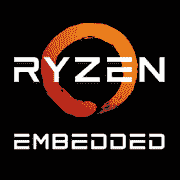AMD Ryzen Embedded R1606G

AMD Ryzen Embedded R1606G: Compact Performance for Basic Tasks
Analysis of the Processor for Budget and Specialized Devices
Architecture and Process Technology: Zen on 14 nm
The AMD Ryzen Embedded R1606G is built on the first-generation Zen microarchitecture, manufactured using a 14-nanometer process. Despite being considered outdated by 2025 (as modern chips utilize 5–7 nm technology), it remains relevant for embedded systems and budget laptops due to its balance of price and energy efficiency.
Cores and Threads:
- 2 physical cores with multithreading support (4 threads).
- Base frequency — 2.6 GHz, maximum in turbo mode — 3.5 GHz.
- L3 cache — 4 MB, which is sufficient for light tasks but limits performance in multitasking scenarios.
Integrated Radeon Vega 3 Graphics:
- 3 compute units (192 shader processors).
- GPU frequency — up to 1200 MHz.
- Support for 4K displays via HDMI 2.0 and DisplayPort.
The first-generation Zen architecture provides basic performance but falls short of newer generations (Zen 3/4) in IPC (instructions per clock). This makes the R1606G optimal for tasks where stability is more important than peak power.
Power Consumption and TDP: A Balance Between Power and Longevity
The processor's TDP is 25 W, allowing it to be used in compact devices without active cooling (e.g., mini PCs) or thin laptops. For comparison, modern mobile Intel Core i5 13th generation processors have a TDP of 15–28 W but offer more cores.
Energy-Saving Technologies:
- Precision Boost 2: Dynamically adjusts frequency based on load and temperature.
- C-states: Manages power consumption in idle mode.
- Adaptive Voltage Scaling: Automatically optimizes voltage to reduce energy consumption.
Performance: What Can the R1606G Do in 2025?
Office Tasks:
- Document editing (Word, Excel), web surfing with 10–15 tabs, Zoom conferences — the processor handles it all without lag.
- Example: Running LibreOffice, Spotify, and the Chrome browser simultaneously while consuming 60–70% of CPU resources.
Multimedia:
- 4K video streaming (YouTube, Netflix) — plays smoothly thanks to Vega 3 decoding capabilities.
- Photo editing in Lightroom: basic adjustments (cropping, color correction) are possible, but exporting will take 2–3 times longer than on 6-core CPUs.
Gaming:
- Vega 3 only handles less demanding projects:
- Minecraft (60 FPS on low settings).
- Dota 2 (720p, 30–40 FPS).
- Indie games (Stardew Valley, Hollow Knight) — stable 60 FPS.
Turbo Mode:
Under 1–2 core load, the frequency rises to 3.5 GHz, but in multithreaded scenarios (rendering, archiving), the chip quickly hits its TDP limit, causing the frequency to drop to 2.8–3.0 GHz.
Use Cases: Who is the R1606G Suitable For?
1. Budget Laptops for Education:
- Text processing, online courses, watching lectures.
- Example: ASUS Vivobook Go 14 laptops (price: $450–$500).
2. Office PCs and Thin Clients:
- Connecting to cloud services, working with CRM systems.
3. Compact Media Centers:
- Streaming video, content streaming to TV.
4. Industrial Systems:
- Managing IoT devices, automation terminals.
Battery Life: How Long Will It Last?
In laptops with a 40–50 Wh battery (for example, HP ProBook 445 G8), the operating time reaches 6–8 hours under moderate load (web browsing, office tasks).
Factors Affecting Longevity:
- Display: Full HD IPS matrix vs. OLED (the latter consumes more power).
- Background Processes: Windows updates, antivirus software reduce operating time by 10–15%.
- Power Saving Mode: Reducing brightness and disabling Turbo Boost can extend battery life by 1–2 hours.
Comparison with Competitors
AMD Ryzen 3 7320U (Zen 2, 6 nm):
- 4 cores / 8 threads, TDP 15 W.
- Geekbench 6: 1100 / 3200.
- Laptop prices: from $600.
Intel Core i3-1315U (10 nm, 2023):
- 6 cores (2P + 4E), 8 threads.
- Geekbench 6: 1350 / 3800.
- Price: from $650.
Apple M1 (5 nm, 2020):
- 8 cores (4P + 4E), Geekbench 6: 2300 / 8300.
- MacBook Air M1 (2025): from $799 (recommended).
Conclusion: The R1606G lags behind modern counterparts in multithreading but excels in device pricing.
Pros and Cons
Strengths:
- Low laptop prices (starting at $400).
- Sufficient performance for basic tasks.
- 4K video support.
Weaknesses:
- Only 2 cores — multitasking is limited.
- Vega 3 is weak for modern gaming.
- 14 nm vs. 5–7 nm in competitors: higher heat and energy consumption.
Recommendations for Laptop Selection
1. Type of Device:
- Ultrabooks (Acer Swift 1).
- Budget Chromebooks (Lenovo IdeaPad Flex 3).
2. What to Pay Attention To:
- Cooling: Even with a 25 W TDP, passive cooling may cause throttling.
- RAM: A minimum of 8 GB DDR4 (16 GB is better for Windows 11).
- Storage: An SSD (256 GB and above) is essential.
3. Price Range:
- New devices with the R1606G cost between $400 and $600.
Final Conclusion
The AMD Ryzen Embedded R1606G is a processor for those seeking an affordable device for basic tasks. It is suitable for:
- Students for educational purposes.
- Office workers dealing with documents.
- Users needing a compact media center.
Key Benefits:
- Low device costs.
- Support for modern interfaces (USB-C, Wi-Fi 6).
- Energy efficiency for prolonged battery life.
If gaming or heavy applications aren’t a necessity, the R1606G is a reliable choice. However, for professional tasks (video editing, 3D modeling), it would be worth considering more powerful CPUs, such as the Ryzen 5 7640U or Intel Core i5-1335U.
Basic
CPU Specifications
Memory Specifications
GPU Specifications
Benchmarks
Compared to Other CPU
Share in social media
Or Link To Us
<a href="https://cputronic.com/en/cpu/amd-ryzen-embedded-r1606g" target="_blank">AMD Ryzen Embedded R1606G</a>